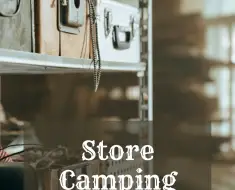
There are many things to consider when you are heading outdoors for the first or one-hundredth time. There are always outdoor risks that you should take into consideration. This is true in life and for outdoor risks. The thing you have to weigh is the risks vs. rewards and what the overall experience will be. If you know what the risks are, you can prepare for them. You learn about the risks of outdoor activity so you can manage them. Like the Boy Scouts motto reads …. “Be Prepared”.
This is not an all-inclusive list of all of the outdoor risks you may find while being outdoors but it is something to consider prior to heading out. However, I did want to take some time to show some outdoor risks to you and some techniques to mitigate those risks.
Check out these tips for hiking safely with children.
Weather
The first and one of the most important outdoor risks to consider is Weather. There’s no such thing as bad weather, just poor clothing. It is important that you check the weather forecast for wherever you are going to ensure that you have packed the right clothing. Most cases of exposure (hot or cold) are caused by not having the right clothing available to accommodate the weather. having the proper clothing for varying conditions will ensure that you can respond to the risk posed by the weather.

The right clothes are the only thing related to the weather. Everywhere I have traveled I hear that old saying, “Just wait a minute and the weather will change”. It only takes a second, but luckily we can use NOAA weather reports and weather radios while we hike to keep us up to date. Remember that depending on where you are going it can rain at any moment. One of the scariest places to be is unprepared in a slot canyon in Utah. It could be raining miles away and sunny over you while you hike. Moments later a deluge can rush through a slot canyon and you won’t have a chance. So take the time early and plan around the weather.
To be prepared for the weather means to understand how to dress appropriately and treat any medical issues that arise from the weather. Taking a basic first aid course before you head out could save you or a loved one’s life. Most first-aid courses will teach you how to cope with heat stroke, hypothermia, or other exposures. If you are unsure about where to find this kind of training then you should check out the Red Cross’s website to learn more.
Animal Encounters

When we head out into nature it is to be with the trees and the fresh air. However, the animals are part of the package. If you are unsure about the type of wildlife in the area then you need to do your research. When you arrive at a state or national park make sure to go to the visitor’s center first. They will have a fantastic knowledge base about the types of wildlife that you may encounter. You might not see a bear, but then again you may. It is important to know and understand how to react in these situations. It could mean life or death.
Remember that the animals are wild and you need to give them space. Do not try and feed the animals. You do not need a picture with a buffalo. It is likely that most of the animals move faster and are more deadly than you think. Numerous people are killed by wild animals each year in national parks because they do not give them the space they deserve.
Consider these 10 safety items to pack for your next trip.
Incorrect Packing
What to pack in is just as important as the contents. Read all about how to select a backpack for hiking and camping!
As mentioned above with the clothing for the weather it’s also important to pack enough clothing. A good rule of thumb. Pack for 2–3 days more than your planned trip. On a day hike, plan for overnight. This is because you never know when something is going to happen. The extra weight that you carry is well worth the extra effort when you are stranded. This goes for food and water as well. If you are not paying attention to where you are going and truly engaging in nature then you may find yourself lost. It could take days or weeks for someone to find you. Having food and water to last is critical. So pack extra dried food, a thermal blanket, and a firestarter just in case. While you do need to consider weight if you are backpacking remember that:
“Having one is having none”.
The most important thing to pack is a basic first aid kit. These can be lifesavers. They contain all of the things you need to handle minor first-aid issues while out camping or hiking. They don’t take up much space but they definitely help when you are in a bind. I’ve used mine 3 times now. Again, having a first aid kit is not enough. You should also be prepared by taking that basic first aid course. This could help teach you how to use things in nature to help you in a medical emergency. For instance, if you are in the woods you may need to build a stretcher out of tree limbs and your thermal blanket. Knowing how to do this could save someone’s life!

Cell Coverage
This is the one outdoor risk everyone forgets! Wherever you go Do NOT count on Google Maps. Always have a backup in place. Google is fantastic in populated areas where there is consistent cell phone coverage. However, even getting into the backcountry near a populated area may lead to degraded cell service. In these cases, if you do not have a backup you may find yourself lost. So plan before you go! Google Maps allows you to download maps to use offline. This could help you get to your main camping area but what about out on the trails?
When hiking and away from your base camp you will likely find even less cell coverage. For these instances, it is helpful to have a handheld GPS. This relies on satellites to help triangulate your position and they are quite reliable. You may need to download maps before heading out so make sure you know how your GPS works. Additionally, they run on batteries so you need to have spare batteries with you. If all else fails, carrying a compass and a waterproof topo map of the area you are hiking is key to finding your way home. Look for your local outdoor groups to get some orienteering experience on how to read and use a map and compass.
Risk vs Reward
The risks of going into the deep woods of the Canadian Rockies are vastly outweighed by the rewards and experience. This is the case no matter where you go. A simple hike on a well-used and known trail can cause severe injury if you take for granted your surroundings. Always be aware of what is occurring around you. Another great example is the people who head to the Grand Canyon each year and try to get photos from the edge. It only takes a second for the rock to crumble and go over the edge. The reward for that wonderful picture is great but the risk is just as high. You must balance the risk vs the reward. Is death really worth that picture or can you get an equally good one from behind the rails and on the marked trail?
Being able to sleep at sunset on the shores of a mountain lake or waking to the sound of a bird call can be magical. That magic can come with a price. If you are prepared for the things you can plan for then you are going to stay safe. There will always be unknowns but doing some survival skill training should help you overcome those difficult moments. So weigh your risk vs reward and get out to nature.
Find the right hiking trail for you so that you limit your risk.
Things to Remember
In the outdoors, you may be miles and hours away from any help. Laying on the ground with a broken limb in a lot of pain is not a fun way to spend your time outdoors. So it only makes sense to know what you are getting into before you commit yourself to it. Knowing the risks upfront will ensure that you can mitigate them as much as possible. Remember you don’t know what you don’t know. So it is important to have contingencies in place.
Important things to consider when mitigating your risk:
- Safety
- Knowledge of the terrain and where you can get help
- Location of supplies or fuel
- Where you can sleep if need be
- Where you can get clean water in an emergency
- Hazardous animals and aquatic life in the area
- Basic first aid










